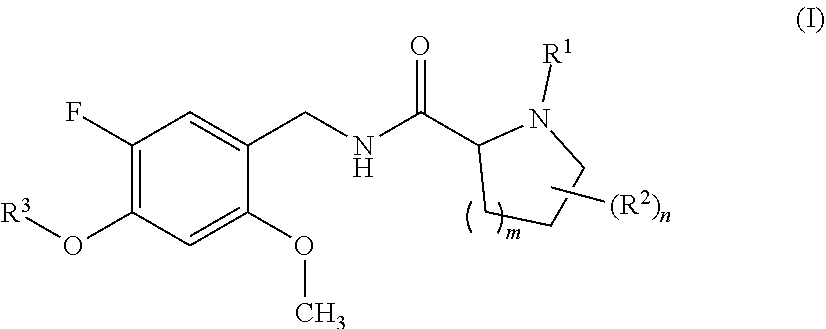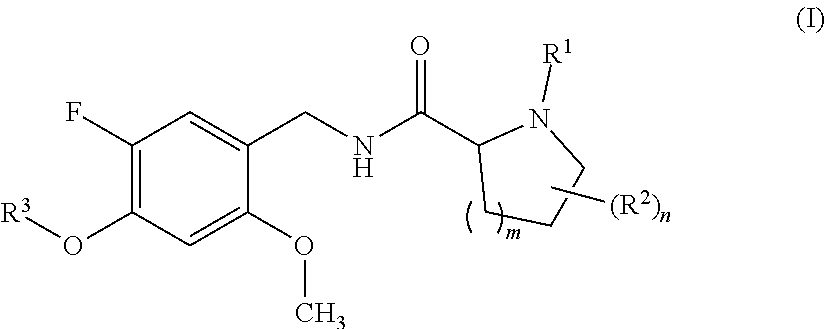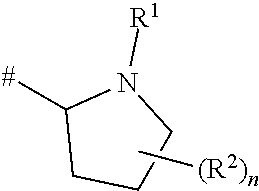Proline amide compounds and their azetidine analogues carrying a specifically substituted benzyl radical
a technology of azetidine and azetidine, which is applied in the field of proline amide compounds and their azetidine derivatives, can solve the problems of limiting therapeutic efficacy, affecting the compliance of negatively afphrenic xpatients, and lack of robust efficacy of atypical antipsychotics against negative and cognitive components of schizophrenic syndrom
- Summary
- Abstract
- Description
- Claims
- Application Information
AI Technical Summary
Benefits of technology
Problems solved by technology
Method used
Image
Examples
example 1
(2S)—N-[[5-Fluoro-4-[(3-fluorophenyl)methoxy]-2-methoxy-phenyl]methyl]-pyrrolidine-2-carboxamide and its Fumaric Acid Addition Salt
[0181]Potassium 2-methylpropan-2-olate (7.86 g, 70.0 mmol) was suspended in THF (80 mL) and the mixture was cooled to 0° C. Phenylmethanol (13.77 g, 127 mmol) was added and the solution was stirred at 0° C. for 30 min followed by dropwise addition to 2,4,5-trifluorobenzonitrile (10 g, 63.7 mmol) in THF (80 mL) at −78° C. under nitrogen. The solution was stirred at −78° C. for 3 h, warmed to room temperature over 1.5 h and stirred at RT for 20 h. The solution was diluted with EtOAc (500 mL) and washed with water (2*70 mL). The water phases were re-extracted with DCM (100 mL*2) and the combined organic phases were concentrated to give crude product, which was recrystallized from EtOH and resulted in 4-(benzyloxy)-2,5-difluorobenzonitrile (10.5 g, 42.8 mmol, 67.3% yield).
[0182]Potassium 2-methylpropan-2-olate (5.86 g, 52.2 mmol) was suspended in THF (50 mL)...
example 2
(2S)—N-[[5-Fluoro-2-methoxy-4-[(2,3,5-trifluorophenyl)methoxy]phenyl]methyl]-pyrrolidine-2-carboxamide and its 2,2,2-trifluoroacetic Acid Addition Salt
[0190]A 4 mL vial was charged with a stir bar, to which was added (S)-tert-butyl 2-((5-fluoro-4-hydroxy-2-methoxybenzyl)carbamoyl)pyrrolidine-1-carboxylate (30 mg, 1 eq., 0.08 mmol; see example 1) in 0.5 ml of dimethyl acetamide followed by 1-(bromomethyl)-2,3,5-trifluorobenzene (22 mg, 1.2 eq, 0.10 mmol) in 0.5 ml of dimethyl acetamide and cesium carbonate (80 mg, 024 mmol, 3 eq.). This mixture was allowed to stir at 60° C. overnight until completion of reaction. Upon completion, the mixture was then filtered and concentrated to dryness. The residue was dissolved in 0.5 ml of 1:1 TFA:Dichloromethane and allowed to stir for 6 hours. Upon completion of the deprotection, the reaction was dried and purified by reverse phase HPLC (TFA method). Samples were purified by preparative HPLC on a Phenomenex Luna C8(2) 5 um 100 Å AXIA column (30 ...
example 3
(2S)—N-[[5-Fluoro-4-[(4-fluorophenyl)methoxy]-2-methoxy-phenyl]methyl]-pyrrolidine-2-carboxamide and its 2,2,2-trifluoroacetic Acid Addition Salt
[0193]The compound was prepared according to example 2 starting from 1-(bromomethyl)-4-fluorobenzene and (S)-tert-butyl 2-((5-fluoro-4-hydroxy-2-methoxybenzyl)carbamoyl)pyrrolidine-1-carboxylate. After BOC deprotection and purification by reverse phase HPLC the desired product (2S)—N-[[5-fluoro-4-[(4-fluorophenyl)methoxy]-2-methoxy-phenyl]methyl]pyrrolidine-2-carboxamide 2,2,2-trifluoroacetic acid salt was obtained.
[0194]MS(APCI+) (M / Z [M+H]+): 377
[0195]1H NMR (400 MHz, DMSO-d6) δ 7.52 (dd, J=8.6, 5.6 Hz, 2H), 7.28-7.19 (m, 2H), 7.03 (d, J=11.8 Hz, 1H), 6.91 (d, J=7.3 Hz, 1H), 5.19 (s, 2H), 4.22 (s, 2H), 4.16 (t, J=7.9 Hz, 1H), 3.23 (ddt, J=31.4, 11.3, 7.2 Hz, 2H), 2.31 (dt, J=13.6, 6.3 Hz, 1H), 1.95-1.76 (m, 3H).
PUM
 Login to View More
Login to View More Abstract
Description
Claims
Application Information
 Login to View More
Login to View More - R&D
- Intellectual Property
- Life Sciences
- Materials
- Tech Scout
- Unparalleled Data Quality
- Higher Quality Content
- 60% Fewer Hallucinations
Browse by: Latest US Patents, China's latest patents, Technical Efficacy Thesaurus, Application Domain, Technology Topic, Popular Technical Reports.
© 2025 PatSnap. All rights reserved.Legal|Privacy policy|Modern Slavery Act Transparency Statement|Sitemap|About US| Contact US: help@patsnap.com



